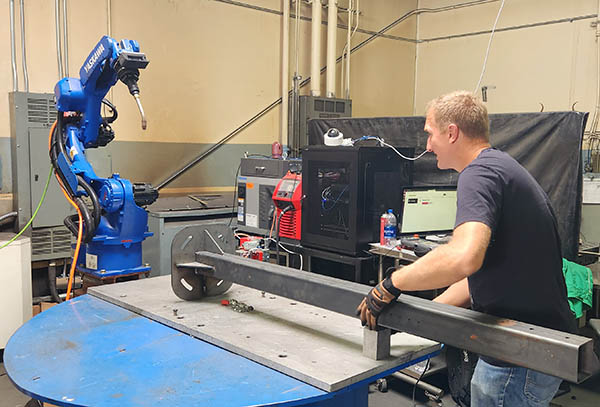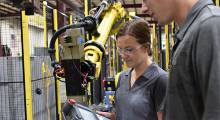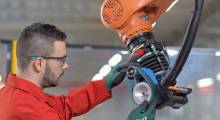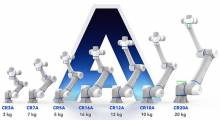While robots have long been used on assembly lines to manufacture millions of identical products, they are becoming more capable for high-mix, low-volume orders. ABAGY Robotic Systems Inc. said its software enables robots to work on individual projects or details, with no programming required.
By 2024, there will be a shortfall of 400,000 welders, compared with the current total of 600,000 welders in the U.S., according to the American Welding Society. Welding robots can help mitigate this shortage, but they need to accommodate customization.
“All of our customers having a hard time hiring welders, whether they're in construction, agriculture, or automotive manufacturing,” said Dmitry Golitsyn, co-founder and chief technology officer of ABAGY.
“Robots haven't been flexible or adaptive enough for non-serial production, and the time needed to reprogram them is not cost-effective,” he told Robotics 24/7. “We developed software for industrial robots to use computer vision, eliminating the need for programming.”
“Teach pendants don't work for non-serial manufacturing; they're designed for full-shift jobs,” explained Golitsyn. “Our user interface allows customers to get the efficiency of a conveyor line for non-serial manufacturing.”
“Offline programming also doesn't work, since parts may not be in an ideal position. Adaptation can take four to five days per job, which is not cost-effective,” he added. “ABAGY's software can do it in minutes, providing the next level of automation.”
Software works with off-the-shelf parts
ABAGY provides its software via subscription as an on-premises solution and in the cloud. It integrates with different robot brands, power sources, and workcell configurations, said Kate Degai, head of marketing at ABAGY.
The Houston-based company uses off-the-shelf parts including standard industrial robots, along with a server, Degai said. ABAGY relies on integrators for distribution and reference customers for demonstrations, she said.
Golitsyn cited bridge manufacturing as an example of the software's ease of use with existing cells or turnkey setups. It works with existing programmable logic controllers (PLCs) and standardized APIs.
“While all bridges are different, an operator can upload a 3D model, select the joints to be welded, and press a button,” said Golitsyn. “There's no orientation planning, and our software can automatically identify weld joints. The user can define parameters and change the sequence.”
“Once the task has been defined, the robot can execute it,” he said. “I can create a task in California and execute it in Chicago. Like with self-driving cars, we're working to Level 5 autonomy, but we're somewhere between Level 3 and 4.”
A number of features can help customers with quality control, Golitsyn noted. “We scan the part with computer vision and identify the position of the workpiece,” he said. “We can not only identify the position, but we can also check if the part is same as the 3D model. If there are deviations above a certain threshold, the system can tell the operator whether to use it or reassemble.”
ABAGY overcomes welder apprehension
ABAGY is continuing to work with customers on refining robotic weld quality and how the software works with different workflows, fixtures, and work areas.
“Working with welders is pretty interesting,” recalled Golitsyn. “Their first reaction is curiosity. They try to challenge the system—after they see the first welds, they discuss whether they can replicate with their hands. Some say they can do better; others say they would never be able to achieve them.”
“Then, there's usually some negativity,” he said. “Welding is a hard task, and you need to learn a lot before you can do it, and it's not easy to admit that robots can do some of it better.”
“After that, we see on each implementation that they're happy,” Golitsyn added. “Teaching a robot to weld is more pleasant than welding itself.”
“There are plenty of different parts to be welded and challenging projects,” he concluded. “The ability to send some work to robot welders is actually a good thing. We're really proud of the ability to take our cars and go over a bridge welded by robots.”
Demonstration sites now open
ABAGY last week said its demonstration robotic workcell is now open at JP Metal Fabrication's (JPMF) manufacturing site in Santa Clara, Calif.
“Our clients successfully use ABAGY at their production sites,” stated Max Zverkov, CEO of ABAGY. “But for new customers, it's essential to see how the technology works in person.”
“Therefore, we turned some of the production solutions into demo sites,” he added. “The first was launched in Illinois with our partner, and the second is located in Kansas.”
“We are happy to open a demo site in California to invite local manufacturers for a demo,” Zverkov said. “Moreover, I live in San Francisco and love it as the technology epicenter and the location of the leading investment funds. On this robotic cell, I personally can present how adaptive robots are and how flexible we can be with any production, including the high-mix market.”
At the JPMF site, specialists upload 3D models of products, and then they select the welds and welding parameters. The Yaskawa robot then automatically welds parts using artificial intelligence and machine vision, adapting to any deviations of the components or their positions.
Switching from one product to another takes only a few minutes, according to ABAGY.
“It's effortless to use. We see a huge difference,” said Danny Ray Leal of JP Metal Fabrication. “I have used a Yaskawa robot before in another facility, and I know what a big programming challenge it was. ABAGY has a very friendly interface and a high-speed launch of a new task for robots.”
ABAGY is scheduling demonstrations at its sites upon request.
About the Author
Follow Robotics 24/7 on Linkedin
Article topics
Email Sign Up
















